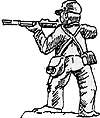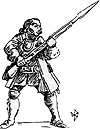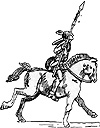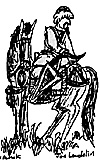 How to use the generic rules
How to use the generic rules
Fill out an attributes sheet for each unit involved. The rules give guidelines for choosing some of the attributes.
Create a marker for each unit, showing its identifier and facing. Home-made cardboard counters are fine for this. Write a unique number on each counter and add an arrow to show the facing and direction of travel.
Find a map to use as the playing area. This can be a commercial map, a home-made sketch, or something in between. The scale does not matter as long as the attributes of each unit match the chosen scale.
TURN SEQUENCE
For each side, in turn:
-
1. Check the chain of command
2. Move all units
3. Carry out ranged fire (not against targets that are adjacent to friendly units). All targets must be declared before any firing calculations start.
4. Carry out close combat (two rounds)
5. Perform spotting checks.
1. CHAIN OF COMMAND
 Any unit that is not a commander has to check whether its commanding unit is within the defined command range, at the start of every turn. If it is not, there is a 50% chance that the unit cannot move or act (1,2,3 on a D6).
Any unit that is not a commander has to check whether its commanding unit is within the defined command range, at the start of every turn. If it is not, there is a 50% chance that the unit cannot move or act (1,2,3 on a D6).
2. MOVEMENT
Typical movement rates (1 MP = 3 mph)
-
Foot: 6 MPs
Mounted: 12
Motorised: 12 - 30
Sea/river : 6 - 12
Halve distance for:
- Uphill
- Woods (Only passable to foot and mounted)
- Marsh (Only passable to foot)
- If unit is damaged
Double distance for roads.
Crippled units cannot move (aircraft move their minimum distance).
Only one action is allowed per turn. An action is usually fire (see phase 3) but it can also cover reloading, embarking & disembarking, repair, etc. Close combat does not count as an action.
For ground-based units:
Crossing any obstacle uses up half of the available movement distance. Any action uses up the other half of the available movement distance. This includes firing, if it is allowed.
3. RANGED COMBAT
All units have a field of view of 90 degrees. Line of sight is blocked by hills, woods, buildings and also by units within 1 MP of the firer or the target.
| Range | Point Blank | Short | Medium | Long | Very Long | Range Level | Roll on D6 to hit |
|---|---|---|---|---|---|---|---|
| Thrown | <1 | 1-2 | 2-4 | 4-6 | 6-8 | Adjacent | Auto hit |
| Handgun | <2 | 2-4 | 4-8 | 8-12 | 12-18 | Point Blank | >=2 |
| Rifle | <3 | 3-6 | 6-12 | 12-18 | 18-24 | Short | >=3 |
| Mortar | <6 | 6-12 | 12-18 | 18-24 | 24-30 | Medium | >=4 |
| Artillery | n/a | <12 | 12-24 | 24-40 | 40-60 | Long | >=5 |
| Missile | n/a | <18 | 18-30 | 30-60 | 60-90 | Very Long | 6 |
To-hit modifiers:
-
Damaged +1 range level
Crippled +2 range levels
Firer has moved this turn +1 range level
Target is vehicle or larger -1 range level
Static target -1 range level
Target's max. speed > 20 +1 range level
Target's max. speed > 30 +2 range levels
Target's max. speed > 50 +3 range levels
If the adjusted range is more than Very Long, no firing is possible.
If a weapon has an area of effect (AoE) > 0 and it misses, its detonation location is D6 units (but max. distance of range/2) in the following direction:
| d6 | ||||
|---|---|---|---|---|
| . | 1,2 | 3,4 | 5,6 | |
| d6 | 1,3 | NW | N | NE |
| 3,4 | W | Dud | E | |
| 5,6 | SW | S | SE | |
Damage to units in the AoE is half the normal damage.
DAMAGE
Damage modifiers:
-
Target in soft cover -1
Target in hard cover -3
Roll a D6 for every damage point. If roll is <= target's ranged defence value, that point is not applied. Otherwise, reduce the target's status by one level, so Undamaged becomes Superficial Damage, then Damaged etc.
4. CLOSE COMBAT
 Units must be adjacent. Divide all combats into pairs of attackers and defenders. A unit can only initiate close combat once per turn but a unit can be attacked any number of times in a turn.
Units must be adjacent. Divide all combats into pairs of attackers and defenders. A unit can only initiate close combat once per turn but a unit can be attacked any number of times in a turn.
Each close combat consists of two rounds, with each unit taking turns as the attacker. The combat results from both rounds are applied simultaneously.
Apply an average die roll to the attacker's and defender's combat strengths:
D6:
-
1 = +1
2 = +2
3 = +2
4 = +3
5 = +3
6 = +4
The lowest score loses. If the defender is the loser, the attacker's close combat damage factor is subtracted from the defender's status.
5. SPOTTING
All enemy units are anonymous until they are:
-
within medium range of any friendly unit, or
within very long range of a unit if they fire.
Once a unit has been identified, it stays identified. Any number of fake units can be added. These are removed as soon as they have been identified.
Typical values:
| Projectile | AoE Damage |
|---|---|
| Contact only | 0/1 |
| Bullet | 0/1 |
| Shrapnel | 1/2 |
| Explosive | 3/3 |
| High Explosive | 8/4 |
| Nuclear | 12/6 |
| Ranged | defence values |
|---|---|
| Foot | 0 |
| Aircraft | 1 |
| Vehicle | 3 |
| Larger | 4 |
AUTOMATION
Movement:
Roll <= Probability of movement
Choose direction and type of movement...
Direction:
-
Adv - Advance
OfL - Outflank to the left
OfR - Outflank to the right
Ret - Retreat
Rnd - Random (use chart for ranged fire)
Route to use:
- Dir - The most direct route
Esy - The easiest route
| d6 | 1 | 2 | 3 | 4 | 5 | 6 |
|---|---|---|---|---|---|---|
| 1 | Adv Dir | Adv Dir | Adv Dir | Adv Esy | Adv Esy | Adv Esy |
| 2 | Adv Esy | Adv Esy | OfL Dir | OfL Dir | OfL Dir | Ofl Esy |
| 3 | OfL Esy | OfL Esy | OfL Esy | OfL Esy | OfR Dir | OfR Dir |
| 4 | OfR Dir | OfR Esy | OfR Esy |
OfR Esy | OfR Esy | OfR Esy |
| 5 | Ret Dir | Ret Dir | Ret Dir |
Ret Esy | Ret Esy | Ret Esy |
| 6 | Ret Esy | Ret Esy | Rnd Dir |
Rnd Dir | Rnd Esy | Rnd Esy |
| Firing: | |
|---|---|
| Range | Probability of firing |
| Point Blank | Always |
| Short | Always |
| Medium | 1-5 on D6 |
| Long | 1-3 on D6 |
| Very Long | 1-3 on D6 |
NOTES
 UNIT NAME: A short, unique identifier for each unit. This is the ID that is put on each counter to show which unit it represents. An alphanumeric code is suitable, such as M1..M6 for six mechanized units, I1..I20 for twenty infantry units. If using chains of command, it can be useful to represent this in the unit Ids, such as X2 is the commanding unit for X21, X22 and X23.
UNIT NAME: A short, unique identifier for each unit. This is the ID that is put on each counter to show which unit it represents. An alphanumeric code is suitable, such as M1..M6 for six mechanized units, I1..I20 for twenty infantry units. If using chains of command, it can be useful to represent this in the unit Ids, such as X2 is the commanding unit for X21, X22 and X23.
DESCRIPTION: A more verbose description of each unit.
STATUS: Draw a circle round the status of the unit. When a unit is damaged, cross out its current status and circle the new status. Units will usually start off Undamaged.
CHAIN OF COMMAND: Circle either Commander or Subordinate to show which type of unit this is. If several levels of command are being used, most units will be both commanders and subordinates.
Commander ID: For a unit that is a subordinate, put the commanding unit's ID here.
Unit ID: For a commanding unit, the units that are being commanded can be listed here. This is optional since all the subordinates will have the commanding unit's ID listed under their attributes.
Range: For a commanding unit, fill in the range of effect for its command. Units within this range are "within command range".
MOVEMENT
Movement type: Circle the type of unit. This can be used to determine default values for its movement attributes. Probability of movement: This is used for automating an opponent's actions, to decide whether or not the unit moves each turn.
Maximum speed: The maximum distance a unit can move in a single turn.
Minimum speed: Airborne units have a minimum movement distance. If they are able to hover, this minimum can be 0.
SPECIAL MOVEMENT RULES: Note any special rules here that apply to movement.
RANGED ATTACK:
 Delivery type: Circle the most suitable type. This mainly affects the chance of hitting a chosen target.
Delivery type: Circle the most suitable type. This mainly affects the chance of hitting a chosen target.
Projectile type: Circle the most suitable type. This can be used to determine default values for the unit's area of effect and damage attributes.
Area of effect: This is only applicable to area effect weapons. Any units within this range of the impact point can suffer damage. Other types of weapons have an area of effect of 0 and only direct hits will cause damage.
Number of shots: If ammunition is limited, note the number of shots available here.
Maximum range: It is not possible to engage targets that are further away than the maximum range.
Minimum range: It is not possible to engage targets that are closer than the maximum range. This value is usually only appropriate for long-range artillery weapons that cannot bring their guns to bear on nearby targets.
Damage: Enter the amount of damage done by each shot.
CLOSE COMBAT ATTACK:
Strength: The attack strength of the unit in close combat.
Damage: The amount of damage that will be inflicted by a successful close combat attack.
CLOSE COMBAT DEFENCE:
Against ranged attack: The chance of deflecting some or all of the damage from a successful ranged attack.
Against close combat: The defence strength of the unit in close combat.
SPECIAL COMBAT RULES:
Note any special rules here that apply to combat.OTHER RULES AND NOTES:
Any other relevant information.Back to Table of Contents -- Lone Warrior #120
Back to Lone Warrior List of Issues
Back to MagWeb Magazine List
© Copyright 1997 by Solo Wargamers Association.
This article appears in MagWeb (Magazine Web) on the Internet World Wide Web.
Other military history articles and gaming articles are available at http://www.magweb.com
